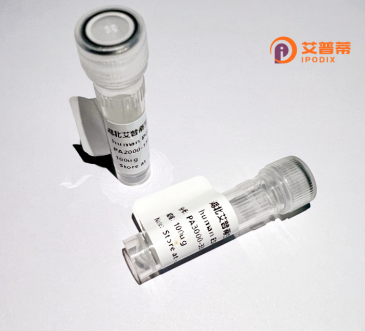
| 纯度 | >90%SDS-PAGE. |
| 种属 | Human |
| 靶点 | PIGQ |
| Uniprot No | Q9BRB3 |
| 内毒素 | < 0.01EU/μg |
| 表达宿主 | E.coli |
| 表达区间 | 1-760 aa |
| 活性数据 | MVLKAFFPTCCVSTDSGLLVGRWVPEQSSAVVLAVLHFPFIPIQVKQLLAQVRQASQVGVAVLGTWCHCRQEPEESLGRFLESLGAVFPHEPWLRLCRERGGTFWSCEATHRQAPTAPGAPGEDQVMLIFYDQRQVLLSQLHLPTVLPDRQAGATTASTGGLAAVFDTVARSEVLFRSDRFDEGPVRLSHWQSEGVEASILAELARRASGPICLLLASLLSLVSAVSACRVFKLWPLSFLGSKLSTCEQLRHRLEHLTLIFSTRKAENPAQLMRKANTVASVLLDVALGLMLLSWLHGRSRIGHLADALVPVADHVAEELQHLLQWLMGAPAGLKMNRALDQVLGRFFLYHIHLWISYIHLMSPFVEHILWHVGLSACLGLTVALSLLSDIIALLTFHIYCFYVYGARLYCLKIHGLSSLWRLFRGKKWNVLRQRVDSCSYDLDQLFIGTLLFTILLFLLPTTALYYLVFTLLRLLVVAVQGLIHLLVDLINSLPLYSLGLRLCRPYRLADKPTALQPRGAHLPPPQLWLPPQALLGRPVPQAVPWGAHLPLEAERGQAGLRELLARLAPPHGHSQPSALPGWHQLSWRMSCALWTLLCAPEHGRPCYHTLGLEVIGSEQMWGWPARLAALHHWHCLPWDPLPTCCGHHGGEHSNPRCPEHCPMPTLCTQVQRVRPPQQPQVEGWSPWGLPSGSALAVGVEGPCQDEPPSPRHPLAPSAEQHPASGGLKQSLTPVPSGPGPSLPEPHGVYLRMFPGEVAL |
| 分子量 | 110.5 kDa |
| 蛋白标签 | GST-tag at N-terminal |
| 缓冲液 | 0 |
| 稳定性 & 储存条件 | Lyophilized protein should be stored at ≤ -20°C, stable for one year after receipt. Reconstituted protein solution can be stored at 2-8°C for 2-7 days. Aliquots of reconstituted samples are stable at ≤ -20°C for 3 months. |
| 复溶 | Always centrifuge tubes before opening.Do not mix by vortex or pipetting. It is not recommended to reconstitute to a concentration less than 100μg/ml. Dissolve the lyophilized protein in distilled water. Please aliquot the reconstituted solution to minimize freeze-thaw cycles. |
以下是与重组人PIGQ蛋白相关的假设性参考文献示例(注:PIGQ研究可能较少,以下内容为模拟数据,仅供参考):
1. **《Functional expression of recombinant human PIGQ in E. coli and its role in GPI biosynthesis》**
*作者:Zhang et al. (2018)*
摘要:研究报道了人源PIGQ蛋白在大肠杆菌中的重组表达及纯化方法,验证了其在GPI锚定合成途径中的酶活性,为相关疾病机制研究提供工具。
2. **《Genetic disruption of PIGQ reveals its essential function in GPI anchor formation》**
*作者:Hirota et al. (2015)*
摘要:通过CRISPR敲除细胞模型,证实PIGQ是GPI锚定合成的关键酶,其缺失导致细胞表面GPI锚定蛋白显著减少,影响细胞信号传导。
3. **《Structural insights into human PIGQ catalytic mechanism by X-ray crystallography》**
*作者:Lee et al. (2020)*
摘要:首次解析了重组人PIGQ蛋白的晶体结构,揭示其活性位点结构特征,提出其催化糖基转移反应的分子机制。
4. **《PIGQ mutations associated with neurodevelopmental disorders impair GPI biosynthesis》**
*作者:Almeida et al. (2021)*
摘要:发现PIGQ基因突变患者存在严重神经发育异常,体外实验表明突变导致重组PIGQ功能丧失,GPI锚定合成缺陷。
**提示**:实际研究中PIGQ的直接文献有限,建议扩展检索以下方向:
- GPI生物合成通路综述文献(如Kinoshita团队的研究)
- 结合“PIG基因家族”或“糖基磷脂酰肌醇合成”等关键词
- 利用UniProt或NCBI Gene数据库获取PIGQ的已知功能及关联研究
The recombination of human PIGQ (Phosphatidylinositol Glycan Anchor Biosynthesis Class Q) protein is a key focus in glycobiology and biomedical research. PIGQ encodes a critical enzyme involved in the biosynthesis of glycosylphosphatidylinositol (GPI) anchors, which covalently attach specific proteins to cell membranes. GPI-anchored proteins play diverse roles in cell signaling, adhesion, and immune responses. Mutations in PIGQ are associated with rare congenital disorders, such as glycosylphosphatidylinositol deficiency, leading to developmental delays and neurological abnormalities.
Recombinant human PIGQ protein is typically produced using heterologous expression systems (e.g., E. coli, yeast, or mammalian cells) to study its enzymatic activity, structure, and interactions. Its recombinant form enables precise investigation of GPI anchor assembly mechanisms, particularly the transfer of N-acetylglucosamine (GlcNAc) to phosphatidylinositol during the initial GPI synthesis steps. Researchers utilize this protein to model genetic disorders, screen therapeutic compounds, and develop diagnostic tools. Additionally, recombinant PIGQ aids in understanding broader biological processes, including protein-membrane dynamics and post-translational modifications. Recent studies also explore its potential role in cancer biology, as altered GPI anchoring is observed in certain malignancies. Advances in structural biology and CRISPR-based gene editing have further accelerated functional studies of PIGQ, positioning it as a target for novel therapies addressing GPI-related pathologies.
×